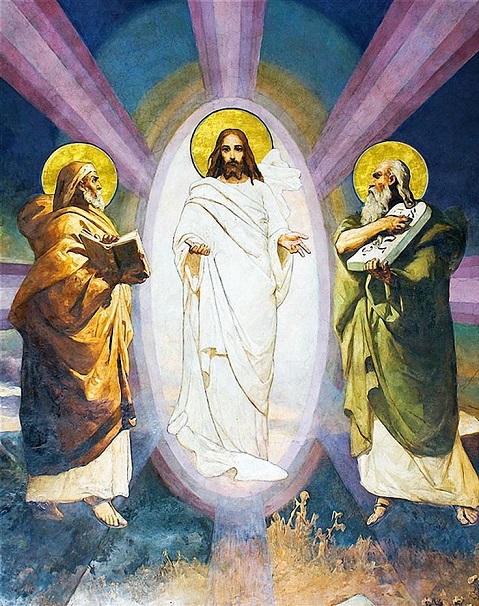Readings: Exodus 34:29-35 | 2 Peter 1:16-21 | Matthew 17:1-9
Text: Matthew 17:1-9
I. The Transfiguration can best be understood in light of the cross, comparing the different features. Our desire is to stay at the Transfiguration because we’ve “arrived.”

a. Immediately before, six days before, Jesus told His disciples, “Truly, I say to you, there are some standing here who will not taste death until they see the Son of Man coming in his kingdom.”(Matt. 16:28)
b. Is this the fulfillment of that word? No, Mount Hermon is not “where it’s at”
c. This is a mystery which the repentant thief understands: “Jesus, remember me when you come into your Kingdom.” (Luke 23:43)
d. Rev. John Bombaro quote:
“The scene at the Transfiguration offers a strange parallel and contrast to crucifixion (Matt 27:33-54). If you’re going to meditate on the Transfiguration, you should hold the crucifixion as a sort of backdrop and terminal point. Here, on the mountain, is Jesus, revealed in glory; but there, on a hillside outside of Jerusalem, is Jesus, revealed in shame. Here his clothes are shining white; there, they have been stripped off, and soldiers have gambled for them. Here on Mount Hermon Christ is flanked by Moses and Elijah, Israel’s greatest heroes representing the law and the prophets; there on the mount of Golgotha, he is flanked by criminals, representing the level to which Jew and Gentile had sunk in their rebellion against God. Here at the Transfiguration a bright cloud illuminates the scene; there at Calvary darkness overshadows upon the land. Here Peter blurts out how wonderful it is; there, Peter is hiding after repeatedly denying he knows Jesus. Here a voice from God declares that this is his wonderful Son; there, a pagan soldier declares, in surprise that this really was God’s Son.
“The mountain-top explains the hill-top; the hill-top explains the mountain-top. We only really understand either of them when we see each side by side with the other.”[1]
e. We too are often hoping that—sometimes quite convinced—that this is the last generation, and we will not have to taste death before seeing Jesus’ coming.
II. In reality, the Transfiguration was an intermediate step. It was necessary to prepare for temporal affliction and doubt.

a. Why the Transfiguration then? Why Peter, James, and John? Why not tell anyone until the Son of Man rises from the dead? Because this “vision” was necessary to give the disciples an anchor to hold them through the Passion and death of the “Christ, the Son of the Living God” and that the “gates of hell should not prevail against [His Church]” (Matt. 16:16-18)—although it sure seemed like the gates of hell had won. It was also needed for all who “come after me, let him deny himself and take up his cross and follow me.” (16:24) The norm is the cross, God’s work hidden under suffering, weakness, and rejection; it’s not the mountaintop.
b. The purpose of the Transfiguration was clear afterward, as Peter eventually would write to the Church in the Epistle today (2 Peter 1:16-21): That the people of God would “have the prophetic Word more fully confirmed.”
III. We are in an “in-between state too” waiting for our Lord’s manifest return.

a. The vision of our Lord’s Transfiguration was sufficient to strengthen the disciples through His Passion. But there is more that happened on the Mountain: The Father spoke and said, “This is my beloved Son, with whom I am well pleased; listen to him.”
b. How often were the disciples were rebuked for not believing the words of Jesus to them? Three times He foretold His coming rejection (Matt. 16:21-23; 17:22-23; 20:17-19). So, the angel at the empty tomb rebuked them (Luke 24:5-7), and Jesus Himself rebuked the disciples (Mark 16:14; Luke 24:25, 38-41). They had not “listened to Him” and look at what duplicity [Peter’s denial], doubt, and fear it had led to!
c. For us, we live in a much longer time awaiting His return. How much harder it is for us, if not for the Holy Spirit, to endure the Last Days! “19 And we have the prophetic word more fully confirmed, to which you will do well to pay attention as to a lamp shining in a dark place, until the day dawns and the morning star rises in your hearts, 20 knowing this first of all, that no prophecy of Scripture comes from someone’s own interpretation. 21 For no prophecy was ever produced by the will of man, but men spoke from God as they were carried along by the Holy Spirit.” (2 Peter 1:19-21)
IV. Christians living in the Last Days especially need to “listen to Him.”

a. How much more we need and want to “listen to Him”! It’s not just a nice option, icing on the cake of being a Christian. We daily need to be in the Word of God, hearing His voice more/louder than the world. We ignore this to our own peril. Many other things will want to “be heard,” but if we are to endure to the end, we must listen to His voice before and above all others.
b. If we are not in our Lord’s Word regularly, we will suffer much worse for our ignorance when we take our cues from our friends; what’s being thrust upon us on TV, YouTube, and Facebook algorithms; how our own flesh wants an easy way out of hardship.
c. What does being in the Word this look like? Find what works for you. Devotions are great prompts. Psalms, devotions, meditations, prayers.
> By listening to the Word of our God, we won’t be saved from hardship, but we will be equipped by Him to take up our cross and follow Him through this passing life into eternal life. In the Name + of Jesus. Amen.

[1] “Jesus’ Transfiguration and Disfiguration” by Rev. John Bombaro https://www.1517.org/articles/jesus-transfiguration-and-disfiguration. Accessed 27 Jan 2023

Leave a Reply